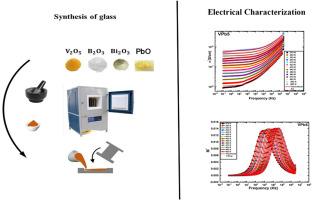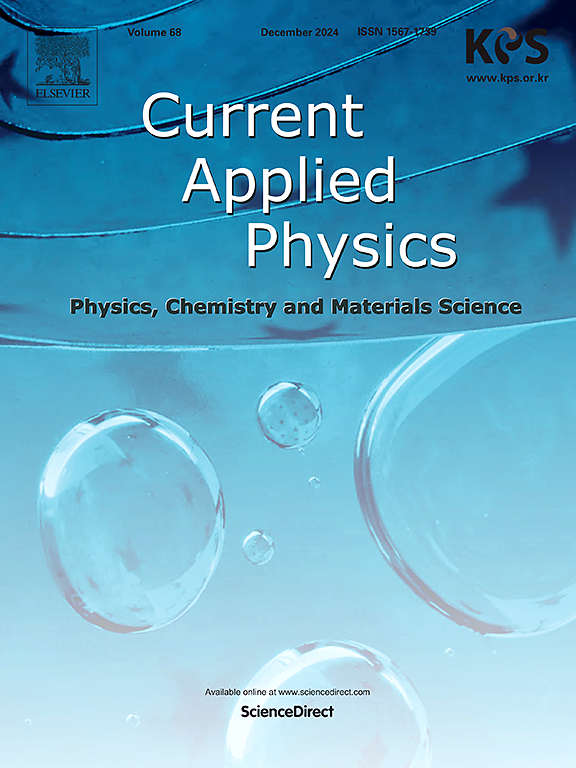铅改性硼钒酸铋玻璃的电学特性分析
IF 2.4
4区 物理与天体物理
Q3 MATERIALS SCIENCE, MULTIDISCIPLINARY
引用次数: 0
摘要
具体来说,该研究考察了铅改性硼钒酸铋玻璃(50-x)V2O5-40 B2O3-10 Bi2O3-xPbO(其中 x = 5、10、15、20 和 25 mol%,样品 ID 为 VPb1、VPb2、VPb3、VPb4 & VPb5)的介电常数(ε′和ε″)、复合模量配方和交流电导率。当氧化铅含量增加时,交流电导率和介电常数都呈下降趋势。为了拟合交流导电率数据,使用了 Almond West 方程来提取参数,包括交叉频率 (ωH)、频率指数 (s) 和直流导电率 (σdc)。除了 VPb5 [所有频率下的相关势垒跳频 (CBH) 传导]之外,所有玻璃样品在较低频率下的直流传导机制都可能归因于大极子量子力学隧道 (LQMT)。与此类似,在高频率下,VPb2 & VPb3 跟着小极子量子机械隧道,而 VPb1 & VPb4 跟着 LQMT。样品 ID 为 VPb1 至 VPb4 的样品在较高频率下的直流传导活化能(Edc)(0.373-0.476 eV)与样品 VPb5 在所有频率下的 Edc 0.686 eV 和模量活化能(ER)(0.382-0.534 eV)非常一致。介电研究显示了非德拜型行为。本文章由计算机程序翻译,如有差异,请以英文原文为准。

Electrical characterization of lead-modified bismuth borovanadate glasses
Specifically, the study looks into dielectric characteristics () and complex modulus formulation and AC conductivity of lead-modified bismuth borovanadate glasses (50-x) V2O5-40 B2O3-10 Bi2O3-xPbO, where x = 5,10, 15, 20 and 25 mol% with sample ID's VPb1, VPb2, VPb3, VPb4 & VPb5 according to different compositions of lead and vanadate. When the PbO content rises, there is a decreasing tendency in both the alternating current conductivity and dielectric constants. In order to fit AC conductivity data, Almond West equation is used to extract parameters, including crossover frequency (), frequency exponent (s), and direct current conductivity (. Direct current conduction mechanism in all glass samples except VPb5 [Correlated Barriers Hopping (CBH) conduction at all frequencies] at lower frequencies might potentially be attributed to large-polaron quantum mechanical tunneling (LQMT). Similar to this, at high frequencies, small polaron quantum mechanical tunnelling is followed by VPb2 & VPb3 while LQMT is followed by VPb1 & VPb4. Activation energy of dc conduction () at higher frequencies (0.373–0.476 eV) for samples having sample ID VPb1 to VPb4 and sample VPb5 at all frequencies with 0.686 eV and modulus activation energy (0.382–0.534 eV) are found in good agreement. Dielectric studies reveal non-Debye-type behaviour.
求助全文
通过发布文献求助,成功后即可免费获取论文全文。
去求助
来源期刊

Current Applied Physics
物理-材料科学:综合
CiteScore
4.80
自引率
0.00%
发文量
213
审稿时长
33 days
期刊介绍:
Current Applied Physics (Curr. Appl. Phys.) is a monthly published international journal covering all the fields of applied science investigating the physics of the advanced materials for future applications.
Other areas covered: Experimental and theoretical aspects of advanced materials and devices dealing with synthesis or structural chemistry, physical and electronic properties, photonics, engineering applications, and uniquely pertinent measurement or analytical techniques.
Current Applied Physics, published since 2001, covers physics, chemistry and materials science, including bio-materials, with their engineering aspects. It is a truly interdisciplinary journal opening a forum for scientists of all related fields, a unique point of the journal discriminating it from other worldwide and/or Pacific Rim applied physics journals.
Regular research papers, letters and review articles with contents meeting the scope of the journal will be considered for publication after peer review.
The Journal is owned by the Korean Physical Society.
 求助内容:
求助内容: 应助结果提醒方式:
应助结果提醒方式:


